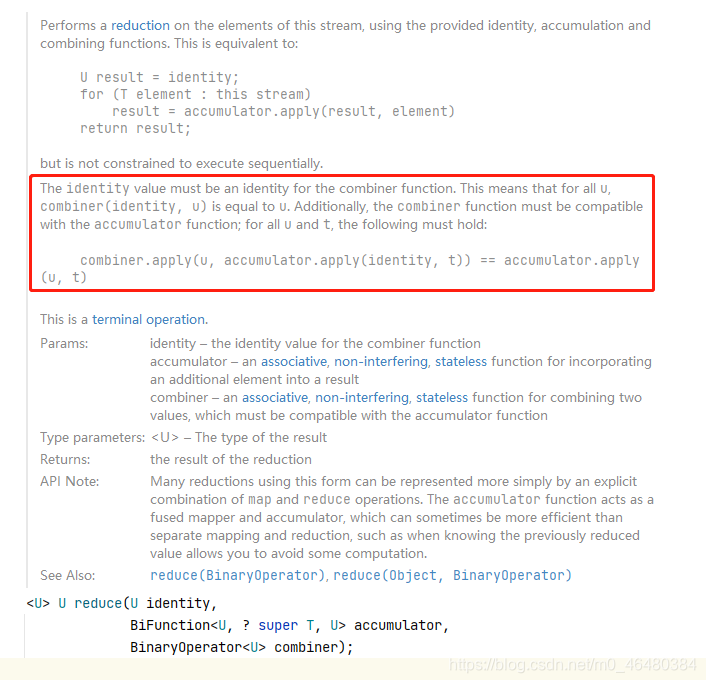关于java源码中Stream#reduce的一个解读
如题,最近遇到一个归约问题引发的源码思考
首先 Stream#reduce 有3个重载方法如下:
T reduce(T identity, BinaryOperator<T> accumulator);
Optional<T> reduce(BinaryOperator<T> accumulator);
<U> U reduce(U identity,
BiFunction<U, ? super T, U> accumulator,
BinaryOperator<U> combiner);第一个方法有两个入参:
- T identity : 意思为累加器 accumulator 的起始点
- BinaryOperator
accumulator : 累加器
此方法比较好理解,归约的过程即对于传入的 identity,将 Stream 流中的每个元素执行传入的累加器 accumulator 中的操作后赋予 identity。
第二个方法只有一个入参,意思与上述类似,区别在于内置的 identity 初始为null,累加器 accumulator 处理完以后的值还是可能为 null,所以返回值用 Optional 包装了一下。
本文的重点在于第三个方法的三个参数:
- U identity:意思为累加器 accumulator 的起始点
- BiFunction<U, ? super T, U> accumulator:累加器
- BinaryOperator< U > combiner:合并器
先来看下官方文档的解释:
accumulator - an associative, non-interfering, stateless function for incorporating an additional element into a result.
累加器 - 一种关联的、无干扰的、无状态的函数,用于将附加元素合并到结果中.
combiner - an associative, non-interfering, stateless function for combining two values, ==which must be compatible with the accumulator function==
组合器 - 一个关联的、无干扰的、无状态的函数,用于组合两个值,==它必须与累加器函数兼容.==
其中重点在于以上标黄字体,其中官方还给了一个具体的解释:
其中框住的描述大致意思为:
标识值必须是组合器功能的标识。 这意味着对于所有 u,combiner(identity, u) 之后的值类型等于 u。 此外,组合器功能必须与累加器功能兼容; 对于所有 u 和 t,以下必须成立:
==combiner.apply(u, accumulator.apply(identity, t)) == accumulator.apply(u, t)==
咋一看还是比较疑惑的,既然以上等式需要成立,为什么还要单独设计累加器和组合器呢?
让我们来看一组代码揭开迷惑:
private static void testForReduce() {
ArrayList<Integer> list = new ArrayList<>();
list.add(2);
list.add(3);
list.add(4);
list.add(5);
Integer reduce = list.stream().reduce(
1,
(x, y) -> {
System.out.println("------accumulator--------"
+ "\nvalue:" + (x + y + 2)
);
return x + y + 2;
},
(x, y) -> {
System.out.println("------combiner--------"
+ "\nvalue:" + (x * y)
);
return x * y;
}
);
System.out.println("result:"+reduce);
}你可以大胆猜测一下结果,如果结果是23,那么建议直接跳到文末看结论即可。
以下为上述代码执行流程:
以上流程中细心的人可能发现了,为什么没有 combiner 的执行流程呢?
注:以上代码中,combiner 确实不参与 reduce 的整个过程中的计算.
那么设计 combiner 的意义何在呢?
下面我们来改造一下代码:
private static void testForReduce() {
ArrayList<Integer> list = new ArrayList<>();
list.add(2);
list.add(3);
list.add(4);
list.add(5);
Integer reduce = list.parallelStream().reduce(
1,
(x, y) -> {
System.out.println("------accumulator--------\n"
+ "ThreadName: " + Thread.currentThread().getName()
+ "\nvalue:" + (x + y + 2) + "\n"
);
return x + y + 2;
},
(x, y) -> {
System.out.println("------combiner--------\n"
+ "ThreadName: " + Thread.currentThread().getName()
+ "\nvalue:" + (x * y)
);
return x * y;
}
);
System.out.println("result:"+reduce);
}以上代码相比于第一次执行的代码:一是将 stream() 改成了 parallelStream(),二是每次打印了当前Thread 名字,下面来看看日志来分析:
------accumulator--------
ThreadName: ForkJoinPool.commonPool-worker-2
value:8
------accumulator--------
ThreadName: ForkJoinPool.commonPool-worker-11
value:5
------accumulator--------
ThreadName: ForkJoinPool.commonPool-worker-9
value:6
------accumulator--------
ThreadName: main
value:7
------combiner--------
ThreadName: ForkJoinPool.commonPool-worker-9
value:30
------combiner--------
ThreadName: main
value:56
------combiner--------
ThreadName: main
value:1680
result:1680结合以上日志,代码的执行流程为:
结合上面的图片,可以清晰的看到:combiner 的执行过程为多个线程之前的合并数据流,所以在之前的单线程处理时,combiner 并不生效。
结论:Stream#reduce 方法的 combiner 在单线程工作时并不生效,combiner 的生效时间在多线程合并时,所以为了保证串行流与并行流的结果一致性,设计了上文中提及的原则:
combiner.apply(u, accumulator.apply(identity, t)) == accumulator.apply(u, t)
如果不满足以上原则,则会造成本文中的两次结果不一致的情形。
引申思考:
- 在多线程之间的数据同步问题需要提前考虑并设计预处理方案。
- 根据本文日志中的 ThreadName 侧面印证了 parallelStream 的底层实际上为 ForkJoinPool,将多个 task 切分给了多个线程工作后再次 join。

bro jie cow pussy
伙计 劫 母牛 猫咪